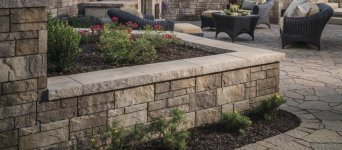EddieWalker
Epic Contributor
I need to build a retaining wall in my backyard so I can change my fencing around for my dogs. Phase one is about 3 feet tall, and probably 20 feet long. Nothing huge. Then Phase two will probably be about the same height, but closer to 50 feet long to create a flower bed.
I have some experience with retaining wall blocks with a lip on them, but I'm considering the type of blocks that are flat and require construction adhesive to hold them together.
As of right now, this is our top choice.

Does anybody have any experience with a brand that worked out well when doing this? I prefer PL over Liquid Nails, but I'd love to learn about another brand that is better for this.
I do a lot of tile work and I'm wondering is something like Thinset Mortar would be better then Construction Adhesive?
On the walls that I've built before, I've always used about 6 inches of Road Base Gravel under the first block. I'm not really sure what this accomplishes, but it seems like the universal agreed upon way of doing it. Would concrete be better? I've also seen where they bury the first row and build up from there. Any thoughts on what works best?
I'm leaning towards just putting landscape fabric against the inside of the blocks and not using any gravel. For 3 feet, and with gaps in every block, I don't see how gravel will help with drainage. Each blocks is designed to drain water when stacked together. The landscape fabric will be more to keep the dirt behind the blocks, then dealing with water.
Thank you
I have some experience with retaining wall blocks with a lip on them, but I'm considering the type of blocks that are flat and require construction adhesive to hold them together.
As of right now, this is our top choice.

Does anybody have any experience with a brand that worked out well when doing this? I prefer PL over Liquid Nails, but I'd love to learn about another brand that is better for this.
I do a lot of tile work and I'm wondering is something like Thinset Mortar would be better then Construction Adhesive?
On the walls that I've built before, I've always used about 6 inches of Road Base Gravel under the first block. I'm not really sure what this accomplishes, but it seems like the universal agreed upon way of doing it. Would concrete be better? I've also seen where they bury the first row and build up from there. Any thoughts on what works best?
I'm leaning towards just putting landscape fabric against the inside of the blocks and not using any gravel. For 3 feet, and with gaps in every block, I don't see how gravel will help with drainage. Each blocks is designed to drain water when stacked together. The landscape fabric will be more to keep the dirt behind the blocks, then dealing with water.
Thank you
